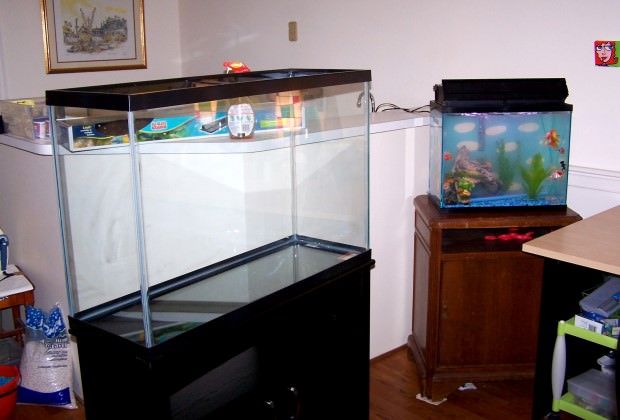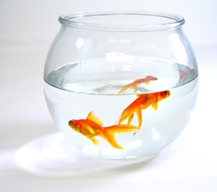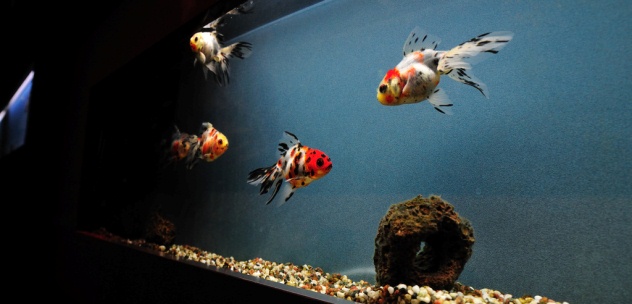
Buying a goldfish tank that is large enough and designed to house the number of goldfish you plan to keep is the first step to raising healthy fish that thrive. The type of aquarium you choose can determine whether your goldfish flourish or just barely survive.
You want a goldfish tank that your fish can comfortably live in.
Goldfish can live for 15 to 20 years, and some have even surpassed the 20-year mark. But to ensure your goldfish reach adulthood, it’s important that you choose goldfish tank your fish will thrive in.
Remember that your goldfish will grow rapidly and will not be an inch long for very long, so you should plan on a larger aquarium to start. – Quick & Easy Goldfish Care by TFH Publications, Inc.
Then there’s the matter of design. Tanks aren’t just the traditional rectangle shape now. You can get fancy and buy a dazzling aquarium specially designed to enhance the beauty of your goldfish.
Let’s take a look at a few goldfish tank requirements, what to avoid, and how to pick the best option for your aquarium needs.
What Size Is Appropriate for a Goldfish Tank?
Get 20 gallons (75 liters) at the very minimum and only if you’re keeping one or two goldfish.
We’ll get to why in a minute, but you don’t want an aquarium smaller than that. Depending on how many goldfish you plan to keep, chances are you’ll want a tank much, much larger.
Yes, I know. Goldfish tanks are expensive. But on the flip side, your goldfish won’t have to breathe through murky water. Assuming the aquarium is properly maintained, of course. And it’s much easier to keep the water crystal clear in a large goldfish tank.
No matter which way you look at it, a small aquarium equates to much more work, frequent water changes, and stressed out goldfish.
In addition to those 20 gallons, you’ll need to add 10 gallons (40 liters) of water for each additional goldfish you buy (if they’re fancy). If you’re keeping slim-bodied goldfish (like commons, comets, or shubunkins), you’ll need even more space – 30 gallons for each additional fish. Take a look at my guide on common goldfish types.
But why all the space?
I’m sure you’ve heard of the one-inch-of-fish-per-gallon rule. But goldfish aren’t like tropical fish, so this rule just doesn’t apply.
Instead…
Buy the Biggest Tank You Can Afford
There are a number of reasons for this. Let’s look at a few.

- Goldfish are very bulky. Because of their odd body shape, they need much more oxygen than slim-bodied, more streamlined fish of the same length. Yes, the one-inch rule might work while your goldfish are young. But as your goldfish grow (and grow quickly), so does their body. Before you know it, your goldfish are quadruple the weight they were previously. And because they’re so heavy, they’ll need even more oxygen. If your tank doesn’t have a lot of space with a wide surface area, you may find your goldfish gasping for breath near the water line. Goldfish bowls are especially harmful because bowls usually have a very tiny surface area with no room for a filtration system.
- A large tank gives your goldfish plenty of room to grow to their full potential. In a small 5-gallon aquarium, your goldfish will still grow. But growth will become stunted, and your goldfish won’t be able to develop properly. In such an environment, goldfish usually don’t last any more than a couple of years. Sadly, many goldfish never live long enough to even grow the 8 inches, 10 inches, or even 20 inches long their body was destined to be.
- Water changes can be very stressful in a small goldfish tank. Goldfish prefer water that maintains a constant temperature. A small aquarium just can’t hold enough water mass. The water will take on whatever temperature the room is, heating up or cooling down much faster than a larger goldfish tank with more water mass (more water allows for slower temperature changes). If someone happens to leave the window open or the power fails and cold air flows into the room, the quick temperature change will cause your goldfish serious stress. And if you’re doing a routine water change (small tanks require more frequent changes), your goldfish can go into shock if you aren’t careful to keep the newly added water the same temperature as the tank.
- Goldfish excrete tons of waste. More waste than most other fish species because of their heavy bodies. So every day that you let your goldfish tank sit, the water quality is getting worse and worse. When you change the water, you’re bringing the water quality back up to its original state. Because larger goldfish tanks have more water mass, the quality of the water decreases slower. Wastes are less concentrated. That’s why you won’t have to do as many routine water changes (or take out more water per change) to keep conditions healthy in a large aquarium. With a 5-gallon tank, you’ll probably have to change the water every day, taking out half of the water per change depending on how many goldfish you have (and how poor water quality is). If you’re late to change the water for whatever reason, your goldfish can quickly become sick.
- The bigger the tank, the less crowded it will be. Overcrowded tanks can cause serious health issues. Water quality worsens at a much faster rate as more waste dissolves and the water becomes more concentrated with harmful toxins. Fish also get more aggressive when they’re overcrowded. So not only are your goldfish stressed out from the poor water quality, but they’re now faced with aggressive tank mates. If they don’t suffer from a few bloody scrapes or torn fins first, a fungal infection is bound to rear its ugly head later.
- Your goldfish tank will fall short. We all have an idea of how we envision our goldfish tank to look like once everything is all set up and running properly. Some fish hobbyists might want to go all out, landscaping the aquarium with all sorts of live plants, pieces of driftwood, and gorgeous waterfall ornaments. Others might want a more simplistic look – a few plastic plants and maybe a treasure cave in the center with holes for hiding. Whatever you envision your goldfish tank to look like, chances are that you won’t be able to achieve the same look with a small aquarium. You’ll want to go much larger, and for some, this may even exceed the 20-gallon requirement.
- You’ll probably want to keep more than one goldfish. Two goldfish can’t thrive in a tank less than 20 gallons. And depending on the type of goldfish you’re keeping, you may need even more space than that. Besides, goldfish are social creatures and prefer the company. So consider how many goldfish (and which goldfish types) you want to keep before buying your goldfish tank.
Even with a large aquarium, you still don’t want to max your tank to capacity. Your goldfish will be a lot happier with a few gallons of extra space. So if you plan to keep four fancy goldfish, you might want to buy a 50-gallon tank, instead of a 40-gallon. Or even a 46-gallon bowfront aquarium.
Buy the biggest tank you can afford. You’ll be happy that you did.
Long or Wide?
Aquariums come in many different shapes and dimensions.

The shape you choose should be carefully considered, since not all of them offer your goldfish the same benefits. Avoid equilateral hexagons, pentagons, and cylinders. These aquariums are usually too deep, and they don’t have a wide surface area like rectangle or bowfront aquariums.
Stay away from long, deep tanks. Goldfish are oxygen hogs and need the extra surface area in wide, horizontal setups. A wide surface area (the space at the top of the aquarium where water meets air) is crucial to keep oxygen levels up and carbon dioxide out. Long aquariums are also harder to work with, since you’ll have to reach far to move around ornaments or plants.
Besides, goldfish are much happier swimming across distances than they are swimming deep.
Acrylic or Glass?
Whether you buy an acrylic or glass aquarium is up to you. Both options have their benefits and disadvantages. Neither one is perfect.
Let’s compare the two.
Acrylic
- Acrylic aquariums are lightweight. In fact, if you take both a glass and acrylic aquarium of the same size and shape, the acrylic tank will be noticeably lighter. That’s because acrylic material is less than half the weight of glass. So you can move much larger acrylic tanks with less effort (and the floor and aquarium stand can more easily handle the weight).
- Acrylic aquariums are very durable. You don’t have to worry about major leaks from cracks or breaks. If there is some sort of collision (your kids are playing ball near the goldfish tank), the aquarium will just bend a little, depending on the force of impact. And since acrylic tanks are bonded rather than seamed together, they hold up better over the long term.
- Acrylic aquariums retain more heat. As you know, fluctuating water temperatures will stress out your goldfish. So by retaining more heat, the tank is able to keep the water temperature more constant.
- The sides of acrylic aquariums are spotless. They don’t have seams or silicone filled corners like glass tanks do (not only can seams take away from the visual appeal, but your goldfish tank can also leak if a seam gets damaged).
- Acrylic aquariums offer a clear, realistic view. The view isn’t as distorted as it is with glass. There’s also no green tint in acrylic material, as there is in some glass aquariums.
- Acrylic aquariums have more design options. You don’t have to stick with a plain rectangle-shaped tank. Enhance the beauty of your goldfish tank with a flat back hexagon or bowfront aquarium.
- Acrylic aquariums can scratch if you’re not too careful. But scratches can also be easily removed. A scratch is also much better than a crack (and potential leak).
- Acrylic aquariums can be a bit pricey. Often, you’ll find the same sized glass aquarium at a cheaper price.
Glass
- Glass doesn’t scratch. But it can break. And then you’re faced with a massive leak.
- Glass aquariums can hold their shape, even if unsupported. If you don’t support the whole acrylic aquarium on a stand, the material can bend over time.
- Glass aquariums maintain the same clarity for years. If you buy an acrylic aquarium made without UV stabilizers, it can yellow or cloud as it ages. Always check to make sure the brand you buy uses this technology before going acrylic.
- Glass aquariums are heavy. Many people recommend acrylic for goldfish tanks larger than 300 gallons, because by that point, glass just becomes too ridiculously heavy to lift (and you’ll need special equipment to even carry the empty aquarium past your front door). The extra weight is also a strain on your aquarium stand and floor.
- Glass aquariums have seams on the corners. Seams can often be damaged while scraping algae off the sides of the aquarium. And if a seam does get damaged, you may have a serious leak on your hands.
- While still clear, glass can have a green tint. This is from the iron in the glass. The more iron the glass has, the greener the tint. And so thicker glass aquariums usually have a greener tint than thinner ones.
- Glass design options are limited. You’ll usually only find glass aquariums in the traditional rectangle shape. But since these aquariums are rectangular, surface area is maximized to provide your fish with better aerated water.
The goldfish tank you choose is up to you. Either an acrylic or glass aquarium will do. But remember: Always buy the biggest aquarium you can afford. Make sure it’s wide (from left to right) and not long (top to bottom). Goldfish need the space to thrive. The more surface area your aquarium has, the better aerated the water will be.
Which Goldfish Tank Do You Prefer?
Do you buy glass or acrylic? What sized aquarium do you have? How many goldfish do you keep? Share your thoughts in the comments below!



71 comments
I have 3 comets and 1 shabunkin in a 22 litre tank is that too many?
Hi Sharen,
4 slim-bodied goldfish in a 22 liter tank is pretty overcrowded. You’ll want to eventually buy a larger aquarium to house all those fish!
Comets and shubunkins are commonly kept as pond fish – you’ll want at least a 416-liter aquarium or pond (110 gallons!) for these fish once they reach adulthood. Eventually, they’ll grow pretty large and will need more space to swim around.
This is a fantastic article! Really covers all the bases. I’m still learning and I wish I had found this to begin with.
Happy to hear it, Samantha! Let me know if you have any specific topics you want me to cover.
How many fish could I put in a 30 litre tank.
Hi Anita,
Unfortunately, 30 liters won’t be enough to house full-grown goldfish. However, guppies or tetras make great community fish for smaller aquariums.
I have a gallon tank with 3 small fish is it too small?
Hi Angelina,
3 goldfish won’t survive for long in a gallon tank. You’ll want to definitely buy a larger aquarium soon, before your fish reach adulthood. I recommend at least 40 gallons for 3 fancy goldfish.
If you’re ever in doubt, make sure to test the water parameters for ammonia and nitrite – both ammonia and nitrite should be at 0ppm (parts per million). You can get both ammonia and nitrite test kits for about $10 or so. If you can’t get ammonia or nitrite close to 0ppm, even with frequent water changes, your tank is overcrowded.
To learn more about this, see my article on water parameters.
How do pet stores keep 20/25 gold fishes in just 100litres of water. I have seen in markets.
Hi Amiya,
Pet stores generally overcrowd their tanks, since the fish aren’t meant to stay for long (usually sold quickly). Plus, these tanks are often connected together for increased water volume (and better overall water quality). Young goldfish also don’t need as much water as adults do.
Hope that helps!.
I didn’t do my homework when my son “won” a goldfish from a fair, I went directly to Petsmart. I was advised (now I know badly) to buy a 10 gallon set and a few more fish to make it worthwhile. I’ve had a ton of trouble keeping the water as it should be, so I decided to buy a 65 gallon tank. I was advised to run the new tank for a week before adding fish. The 10 gallon is still problematic and since I keep being told different things, what should I do?
Hi Dawn,
By now your tank is probably finished with the nitrogen cycle, so hopefully you managed to get everything up and running without many problems. You can always use your 10 gallon as a hospital tank in case your goldfish ever get sick.
If anything should happen to the 65 gallon tank and you do need to house your goldfish in the 10 gallon temporarily, I recommend frequent water changes to keep water quality under control. You can also try running both a sponge filter and power/canister filter in the same tank – I’ve had great results with this. And sponge filters provide excellent biological filtration. But definitely keep an eye on those water parameters. When you have an overcrowded tank, it’s very important that you test for ammonia, nitrite, and nitrate frequently to make sure there aren’t any surprises.
In any case, I’m happy to hear your goldfish now have plenty of space to move around, not to mention the healthier aquarium environment! Let me know how they enjoy their new home. 🙂
My brother has four goldfish in a 10 gal tank. Each fish is about 3-4 inches long. Should I tell him to get a bigger tank?
Definitely! You don’t want those water parameters to get out of control. And 4 goldfish in a 10 gallon tank is definitely overcrowded. If they’re fancy goldfish, aim for at least 50 gallons. Your brother’s goldfish will need much more space than a 10 gallon tank can provide as the fish get older.
In the meantime, test the water with an ammonia or nitrite test kit to check on water quality. In a healthy aquarium environment, ammonia and nitrite should both be at 0ppm (parts per million). If you need help with this, see my water parameter guide.
I have a fantail in a 17 litre tank by himself. Is that enough space?
Hi Hannah,
I wouldn’t recommend a 17-liter tank for a fancy goldfish. If your fantail is still young, you might get a couple months out of it, but eventually you’ll want to purchase at least a 76-liter aquarium (or 20 gallon tank). Your goldfish may even do fine in a 38 or 58-liter tank (10 or 15 gallons) if you simply don’t have the space for a larger aquarium right now, as long as you stay on top of water changes and water testing. Make sure you also have a good filtration system (I personally use power filters in my tanks, but canister filters are also very good). If your filter needs the extra help, you can even attach a sponge filter to the glass – these filters are really good at biological filtration.
Keep ammonia and nitrite levels at 0ppm (parts per million) and nitrate below 40ppm and your goldfish will be fine. You can read more about this in my water parameter guide. If you’re finding it tough to maintain zero ammonia and nitrite in the aquarium – even with a good filter and routine water changes – you’ll need to start looking at larger aquariums.
In a small tank, you may need to perform water changes more frequently than you would a larger aquarium. So if ammonia or nitrite is getting out of hand, try changing 25% of the water twice or three times per week. If that doesn’t help, change 50% of the water twice or three times per week until you can afford a roomier home for your goldfish. Make sure that all water going in is around the same temperature and pH as the water already in the aquarium – particularly if you’re doing large water changes! You don’t want to shock your goldfish.
Hope that helps!
I have one goldfish that was living in a 2 liter bottle (set lengthwise) at my daughter’s school. Immediately went out and purchased him a 10 gallon tank. He seems pretty happy but all my reading is leading me to believe he is going to get quite a bit bigger. There will be a point when my husband won’t be supportive of my buying larger and larger tanks. Are there places that take larger goldfish?
One fancy goldfish can live quite comfortably in a 20-gallon tank. But if you’re still looking to give your fish away, you can try calling local pet stores (the smaller shops, rather than the large chains, may be more willing to accept new fish), Craigslist – even a close friend or family member. Sadly, I’m not familiar with many places to give away fish. If anyone else has first-hand experience, feel free to drop your suggestions. 🙂 You can also try asking your question on other goldfish forums (there’s a really good community over at Koko’s Goldfish – you can try your question there).
Hello. I’ve found your website to be informative and clear. I’m giving the hobby some serious thought. I understand clearly that for a beginner fewer fish are better and thus a smaller tank. I’d like to ask you how many Common Goldfish would be appropriate for 200 litres?
Hello Andre! Glad you found the website helpful. For common goldfish, I’d recommend only one or two in a 200-liter tank. These fish are really best suited in an outdoor pond though. If you’re just starting out, you should consider the fancy varieties – black moors, fantails, and ryukins are excellent choices because they’re so hardy. You can fit about 3 to 5 fancy goldfish in 200 liters of water comfortably, but I’d suggest starting off small – don’t get too many fish at once until your aquarium is more established. And before buying any new fish, set up your aquarium a few weeks in advanced so the nitrogen cycle has time to run its course. If you have any other questions, don’t hesitate to ask! I really hope you enjoy the goldfish hobby! 🙂
I have a 53 gallon glass tank with three young fancy goldfish!! Buggy is a black moor, Goldie is a fantail,and Lilly is the smallest baby raunchu . I would prefer a acrylic but I got my tank at the pet shop on a dollar per gallon sale and they didn’t have much left to choose from !!
That’s so awesome, Sandra! My local pet shop was having the very same sale actually. Sadly, I wasn’t able to pick up another aquarium for myself. But I’m sure your goldfish are going to really like their new home. 🙂 They all sound beautiful – especially the ranchu! I love it when goldfish are so young – they’re always so curious and fun! Plus, you get to watch them grow. It’s amazing how big goldfish can get in a couple months!